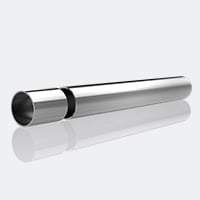Introduction

Choosing the right stainless steel tube for your project can significantly impact the success and longevity of your application. With a variety of grades, sizes, finishes, and specifications available, making the best choice requires an understanding of your specific needs and the properties of different stainless steel tubes. In this comprehensive guide, we will explore the key factors to consider when selecting a stainless steel tube, providing you with the knowledge to make an informed decision.
Understanding Stainless Steel Tubes
What is a Stainless Steel Tube?
A stainless steel tube is a hollow, cylindrical shape made from an alloy of iron, chromium, and other elements. It is known for its corrosion resistance, strength, and durability, making it ideal for a wide range of applications across various industries, including construction, automotive, aerospace, and food processing.
Types of Stainless Steel Tubes
Stainless steel tubes come in different types, each suited for specific applications:
- Seamless Tubes: Made by extruding steel to the desired length, these tubes are known for their high strength and resistance to pressure.
- Welded Tubes: Created by welding a steel strip, these tubes are cost-effective and available in longer lengths.
- Sanitary Tubes: Designed for hygienic applications, these tubes have a smooth internal surface to prevent contamination.
- Instrumentation Tubes: Used in precision applications, these tubes have tight tolerances and high purity standards.
Key Factors to Consider
1. Grade Selection
Different grades of stainless steel offer varying levels of corrosion resistance, strength, and weldability. Common grades include:
- 304: General-purpose grade with good corrosion resistance and formability.
- 316: Contains molybdenum for enhanced corrosion resistance, especially against chlorides.
- 321: Titanium-stabilized grade with excellent resistance to intergranular corrosion.
- 410: High strength and wear resistance, suitable for mechanical applications.
2. Size and Dimensions
The size and dimensions of the stainless steel tube are critical for ensuring a proper fit and functionality. Key dimensions include:
- Outer Diameter (OD): The measurement of the tube’s external surface.
- Wall Thickness: The thickness of the tube’s wall, affecting its strength and weight.
- Length: The tube’s length, which can be customized to meet specific requirements.
| Grade | Outer Diameter (OD) | Wall Thickness | Length |
|---|---|---|---|
| 304 | 1/2″ – 12″ | 0.035″ – 0.500″ | Up to 20′ |
| 316 | 1/4″ – 8″ | 0.020″ – 0.375″ | Up to 18′ |
| 321 | 1/8″ – 10″ | 0.028″ – 0.438″ | Up to 22′ |
| 410 | 1/4″ – 6″ | 0.049″ – 0.250″ | Up to 16′ |
3. Surface Finish
The surface finish of a stainless steel tube can affect its appearance, cleanliness, and corrosion resistance. Common finishes include:
- Mill Finish: Basic finish with a dull appearance, suitable for non-decorative applications.
- Polished Finish: Provides a shiny, smooth surface for decorative and hygienic applications.
- Brushed Finish: Features a uniform, satin-like texture, often used in architectural applications.
4. Mechanical Properties
Consider the mechanical properties required for your application, such as tensile strength, yield strength, and hardness. These properties will determine the tube’s ability to withstand mechanical stresses and loads.
5. Corrosion Resistance
Evaluate the environmental conditions the stainless steel tube will be exposed to, including exposure to chemicals, moisture, and temperature variations. Select a grade with appropriate corrosion resistance to ensure longevity and performance.
Applications of Stainless Steel Tubes

Stainless steel tubes are used in a wide range of applications due to their versatility and reliability. Some common applications include:
- Construction: Structural supports, handrails, and architectural features.
- Automotive: Exhaust systems, fuel lines, and hydraulic tubing.
- Aerospace: Aircraft frames, hydraulic systems, and fuel lines.
- Food Processing: Conveyors, piping systems, and equipment frames.
Conclusion
Selecting the right stainless steel tube for your project involves careful consideration of various factors, including grade selection, size and dimensions, surface finish, mechanical properties, and corrosion resistance. By understanding these key aspects and evaluating your specific needs, you can make an informed decision that ensures the success and longevity of your application.
FAQ
Q: What is the difference between seamless and welded stainless steel tubes?
A: Seamless stainless steel tubes are made by extruding steel to the desired length, resulting in a tube without any welds. They offer high strength and pressure resistance. Welded stainless steel tubes, on the other hand, are created by welding a steel strip into a cylindrical shape. They are cost-effective and available in longer lengths but may have slightly lower strength compared to seamless tubes.
Q: How do I choose the right grade of stainless steel for my application?
A: The choice of grade depends on the specific requirements of your application, including corrosion resistance, mechanical strength, and weldability. Common grades like 304 and 316 are suitable for general-purpose applications, while grades like 321 and 410 offer specialized properties for high-temperature and mechanical applications, respectively.
Q: Can stainless steel tubes be customized to specific lengths and dimensions?
A: Yes, stainless steel tubes can be customized to meet specific length and dimension requirements. It’s essential to work with a supplier who can provide the necessary customization to ensure a proper fit and functionality for your application.
Q: What factors should I consider when selecting the surface finish of a stainless steel tube?
A: When selecting the surface finish, consider factors such as appearance, cleanliness, and corrosion resistance. Mill finishes are suitable for non-decorative applications, polished finishes provide a shiny and smooth surface for decorative and hygienic uses, and brushed finishes offer a uniform, satin-like texture for architectural applications.
Q: How can I ensure the quality and reliability of stainless steel tubes for my project?
A: To ensure quality and reliability, work with reputable suppliers who provide certified materials and adhere to industry standards. Additionally, request material test reports (MTRs) and certifications that verify the chemical composition and mechanical properties of the stainless steel tubes.
